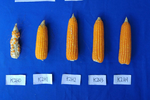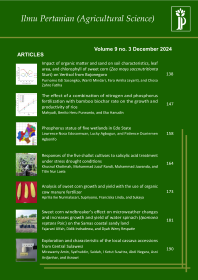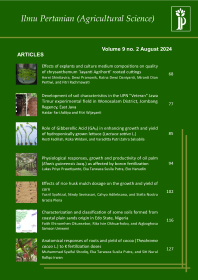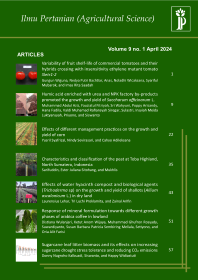
Effect of humic acid on the growth and yield of two maize (Zea mays L.) cultivars on andisol
Tangguh Prakoso(1*), Endang Sulistyaningsih(2), Benito Heru Purwanto(3)
(1) Department of Agronomy, Faculty of Agriculture, Universitas Gadjah Mada Jln. Flora, Bulaksumur, Sleman, Yogyakarta 55281
(2) Department of Agronomy, Faculty of Agriculture, Universitas Gadjah Mada Jln. Flora, Bulaksumur, Sleman, Yogyakarta 55281
(3) Department of Soil Science, Faculty of Agriculture, Universitas Gadjah Mada Jln. Flora, Bulaksumur, Sleman, Yogyakarta 55281
(*) Corresponding Author
Abstract
One way to improve maize (Zea mays L.) production is through land extension using Andisol land. However, Andisol soil has phosphate (P) fixation problem due to the high amorphous material. Hence, the use of organic material in the form of humic acid that has greater affinity to amorphous minerals is recommended to solve the problem. This research was conducted in February-May 2017 at Tri Dharma field of Faculty of Agriculture, Universitas Gadjah Mada. The Andisol land used has a low available P category from Datar, West Java and Wonosobo, Central Java. This research was arranged in a Randomized Complete Block Design (RCBD), consisting of two factors. The first factor was maize cultivar (Bisi-2 and Pioneer-35). The second factor was the doses of humic acid, consisting of control treatment (without fertilizer and humic acid), NPK without humic acid, and NPK + humic acid at 5%, 10%, and 15%. The percentage of humic acid given, based on the amount of NPK 16:16:16 fertilizer, was 350 kg.ha-1. Fertilization was applied three times 100 kg.ha-1 on 1 WAP, 150 kg.ha-1 at 3 WAP and 100 kg ha-1 at 7 WAP. The results is, humic acid treatment had the same effect with NPK fertilization treatment only and control on P available Andisol soil. Humic acid, also has the same effect with NPK fertilizer treatment in increasing the yield component of 100 seeds weight, dry weight of seeds, harvest index, length of cobs and productivity.
Keywords
Full Text:
PDFReferences
Balitanah. (2009). Analisis Kimia Tanah, Tanaman, Air, dan Pupuk. bogor.
Date, R. A., Grundon, N. J., Rayment, G. E., & Probert, M. E. (1995). Plant-Soil Interactions at Low pH : Principles and Management. Plant and Soil, 64(1), 824. https://doi.org/10.1007/978-94-011-0221-6
Elfiati, D. (2005). Peranan Mikroba Pelarut Fosfat Terhadap Pertumbuhan Tanaman. E-USU Repository, 1–10.
Embleton, T, Jones, W, Pallares, C, Platt, R. . (1978). Effects of fertilization of citrus on fruit quality and ground water nitrate-pollution potential. Proc. Int. Soc. Citriculture, 280–285. Retrieved from http://www.crec.ifas.ufl.edu/academics/classes/hos6546/materials/ISC_1978_281-285.pdf
Hermanto. (2012). Ketersediaan Dan Pengambilan Nutrien Pada Tanaman, 69–75.
Hill, B. E. (2009). Soil sample handling for routine analysis of plant- available soil potassium, 43.
Kementerian Pertanian. 2010. Identifikasi Gejala Kekurangan Unsur Hara pada Tanaman Jagung. NTB.
Mosse, B. 1981. Vasicular Arbuscular Mycoriihiza Research for Tropical Agriculture. Institute of Tropical Agriculture and Human Resources University of Hawaii. Hawaii.
Munir, M. 1996. Tanah-Tanah Utama Indonesia, Karakteristik Klasifikasi dan Pemanfaatannya. PT. Dunia Pustaka Jaya, Jakarta.
Murbandono, L. 2000. Membuat Kompos. Penebar Swadaya. Edisi Revisi, Jakarta.
Nyanjang, R., A. A. Salim., Y. Rahmiati. 2003. Penggunaan Pupuk Majemuk NPK 25-7-7 Terhadap Peningkatan Produksi Mutu Pada Tanaman Teh Menghasilkan di Tanah Andisols. PT. Perkebunan Nusantara XII. Prosiding Teh Nasional. Gambung. Hal 181-185.
Putro, D., & Baskoro, T. (2010). The Effect of Humic Substance and Green Manure on Soil Physical Properties and Cassava Production. Jurnal Tanah Dan Lingkungan, 12(1), 9–14.
Raihan, H., S. 2002. Pemupukan NPK dan Ameliorasi Lahan Pasang Surut Sulfat Masam Berdasarkan Nilai Uji Tanah untuk Tanaman Jagung. Ilmu Pertanian. 9 (1) : 20-28.
Sarno, & Firtia, E. (2012). Pengaruh Aplikasi Asam Umat dan Pupuk N tehadap Pertumbuhan dan Serapan N pada Tanaman Bayam (Amaranthus spp.). Prosiding SNSMAIP, 3(978), 288–293.
Stevenson, F. J. And M. A. Cole. 1999. Cycles of Soil, Carbon, Nitrogen, Phosphorus, Sulfur, Micronutrients 2nd Ediion. John Wilet and Sons, Inc. New York.
Subagjo, H., N. Suharta dan A.B. Siswanto. 2004. Tanah-Tanah Pertanian di Indonesia. Hlm 21-65. Dalam Adimihardja et al. (Eds.). Sumberdaya Lahan Indonesia dan Pengelolaannya. Pusat Penelitian dan Pengembangan Tanah dan Agroklimat, Badan Litbang Pertanian, Departemen Pertanian, Bogor
Sukarman, & Dariah, A. (2014). Tanah Andosol Di Indonesia.
Tan, KH. 2011. Principles of Soil Chemestry fourth edition. New York (USA): Marcel Dekker.
Uehere, G. And G. Gillman. 1982. The Mineralogy, Chemistry and Physics of Tropical Soils Variable Charge Clays. Westview Press. Boulder. Colorada. Xxviii + 170 h
Winarso, S. 2005. Kesuburan Tanah Dasar Kesehatan dan Kualitas Tnah. Yogyakarta: Gava Media
Wissuwa, M., Gamat, G., & Ismail, A. M. (2005). Is root growth under phosphorus deficiency affected by source or sink limitations? Journal of Experimental Botany, 56(417), 1943–1950. https://doi.org/10.1093/jxb/eri189
Article Metrics
Refbacks
Ilmu Pertanian (Agricultural Science) ISSN 0126-4214 (print), ISSN 2527-7162 (online) is published by Faculty of Agriculture Universitas Gadjah Mada collaboration with Perhimpunan Sarjana Pertanian Indonesia (PISPI) and licensed under a Creative Commons Attribution-ShareAlike 4.0 International License.













